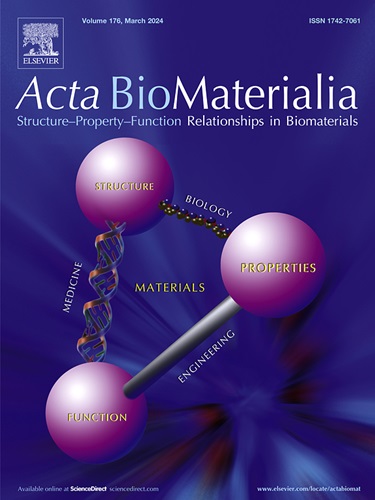Homocysteine leads to aortic stiffening in a rabbit model of atherosclerosis
IF 9.6
1区 医学
Q1 ENGINEERING, BIOMEDICAL
引用次数: 0
Abstract
Hyperhomocysteinemia, an elevated level of homocysteine in the blood, is an independent risk factor for atherosclerosis and, more generally, cardiovascular disease. However, its relationship with aortic biomechanics has not been investigated yet. To better understand the influence of elevated homocysteine levels on aortic biomechanics, we propose an animal model in which hyperhomocysteinemia, hypercholesterolemia, and their combination were induced in rabbits by balloon injury of the abdominal aorta, special diets, and intravenous homocysteine injections. The effects of a diet deficient in B vitamins and choline, which are required for homocysteine degradation, a cholesterol-rich diet, their combination, and increased homocysteine concentration are investigated in relation to abdominal aortic biomechanics in rabbits. For this purpose, equibiaxial and non-equibiaxial extension tests were carried out, and the influence of risk factors on the stress–stretch relationship, mechanical anisotropy, and tissue inelasticity is discussed. The mechanical characterization of the tissue was supported by microstructural histological analyses. Our study reveals that deficiency of B vitamins and choline cause aortic stiffening even in the absence of hypercholesterolemia, suggesting a possible independent role in the development of atherosclerosis. Further increasing homocysteine concentration through intravenous injections in rabbits fed B vitamins and choline-deficient diet also results in a stiffer stress response and more pronounced inelastic phenomena with respect to the control group.

同型半胱氨酸导致动脉粥样硬化兔模型主动脉硬化。
高同型半胱氨酸血症,血液中同型半胱氨酸水平升高,是动脉粥样硬化的独立危险因素,更普遍的是心血管疾病。然而,其与主动脉生物力学的关系尚未研究。为了更好地了解同型半胱氨酸水平升高对主动脉生物力学的影响,我们提出了一种动物模型,通过腹主动脉球囊损伤、特殊饮食和静脉注射同型半胱氨酸来诱导兔高同型半胱氨酸血症、高胆固醇血症及其合并。研究了缺乏同型半胱氨酸降解所需的B族维生素和胆碱的饮食、富含胆固醇的饮食、它们的组合以及同型半胱氨酸浓度增加对家兔腹主动脉生物力学的影响。为此,进行了等双轴和非等双轴拉伸试验,讨论了危险因素对应力-拉伸关系、力学各向异性和组织非弹性的影响。显微结构组织学分析支持组织的力学特性。我们的研究表明,即使在没有高胆固醇血症的情况下,维生素B和胆碱缺乏也会导致主动脉硬化,这表明维生素B和胆碱在动脉粥样硬化的发展中可能具有独立的作用。通过静脉注射维生素B和胆碱缺乏饲料的家兔进一步增加同型半胱氨酸浓度,也会导致与对照组相比更僵硬的应激反应和更明显的非弹性现象。
本文章由计算机程序翻译,如有差异,请以英文原文为准。
求助全文
约1分钟内获得全文
求助全文
来源期刊

Acta Biomaterialia
工程技术-材料科学:生物材料
CiteScore
16.80
自引率
3.10%
发文量
776
审稿时长
30 days
期刊介绍:
Acta Biomaterialia is a monthly peer-reviewed scientific journal published by Elsevier. The journal was established in January 2005. The editor-in-chief is W.R. Wagner (University of Pittsburgh). The journal covers research in biomaterials science, including the interrelationship of biomaterial structure and function from macroscale to nanoscale. Topical coverage includes biomedical and biocompatible materials.
 求助内容:
求助内容: 应助结果提醒方式:
应助结果提醒方式:


